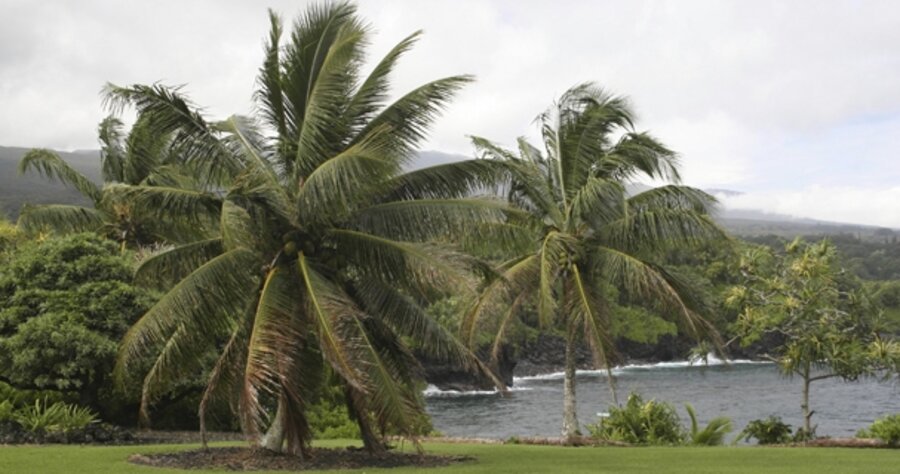A gift of 'Aloha'
Loading...
As a California native, I connect with a buckeye’s independence, an oak’s royal hillside stance, and a manzanita’s gnarly attitude, but under Maui’s afternoon sun, I had trouble feeling anything for the heart-shaped leaves of a taro plant. With its leaves looking as wilted as I felt, it was hard to muster the respect that the plant deserved.
With brochure in hand, I was touring the Kahanu Garden, an ethno-botanical sacred site northwest of Hana, complete with a three-acre lava-stone pyramid with its top lopped off.
This national historic landmark, Pi’ilani Heiau, is the largest temple in Hawaii, but to me, it looked like a pile of black rocks. I moved on to the next “essential to Hawaiian living” plant listed, but only because it offered shade.
I normally relish the chance to learn about plants, but I was drained after a long hike in the Haleakala National Park, and the afternoon heat conspired with the white broccoli-shaped clouds to induce a longing for a siesta.
But I trudged on. Then a gray-haired Asian man wearing thick glasses came down the trail, smiled, and said, “Aloha.”
There was something in his greeting that held an invitation, so I stopped. Gifts often come in unexpected packages, I’ve found, and this one was wrapped in shorts, faded T-shirt, and tube socks.
“Aloha,” I said.
“Do you want to hear a story?” he asked.
He walked over to a naupaka kahakai plant and picked two flowers.
“See how each flower is only half a flower?” he asked. “Legend says that these flowers were once lovers, but were separated when one went to the mountains and the other to the sea. To unite the lovers, you bring the two flowers together to form one. See?”
I liked his story, and told him so. “Are you a docent here?” I asked.
“No, I’m a donor. My family owned this land. I’m Edwin Matsuda,” he said, hand extended. “But people call me Take.”
Take Matsuda was a direct descendent of Chief Kahanu, who had been given the property by King Kamehameha III in 1848.
On the day I visited, Mr. Matsuda’s family was meeting on the property for a reunion in honor of his mother. He reached for my brochure, leafed through it, and showed me her picture. Martha Mileka Kahanu Matsuda-Iwanaga wore her long hair twisted in a thick mound at the back of her neck and her focus was away from the camera.
He darted from story to story, such as how his great-grandfather was a mail carrier on the Hana Highway when the muddy road was almost too narrow for two horses to pass.
“King Pi’ilani ruled these lands a long time ago,” he said, looking over the garden’s expanse.
I followed his gaze, and it seemed as if the clouds and the temple below them were designed to exist in perfect synergy.
After a few more stories, Matsuda left with a cheery “aloha” and continued into the garden where he had played as a boy and where his cue to go home was the hibiscus flowers changing from yellow to red at dusk.
I went to an open-air shelter that displayed information about the garden and read that the common people had “showed their aloha” by building the Pi’ilani Heiau.
“Showed their aloha?” I didn’t understand. I thought that aloha was a greeting given by a beautiful Hawaiian woman when she placed a lei over your head.
There must be more to aloha than I thought.
Later that night at my rented cottage, I told the landlady about Matsuda.
She put her hands together in an impromptu prayer. “That was a blessing,” she said. "Those old Hawaiian families are hard to find – and harder to meet.”
After returning to California, I Googled the word “aloha” and learned that the “spirit of aloha” means the very breath of life, a way of living that treats all living things with love and respect, from the plants in a garden to the people that you meet.
Only a few days after this discovery, I was stuck in a traffic jam. I tried hard to retain that “vacation feeling” by thinking about “aloha.” As I neared a tollbooth, an old Cadillac swooshed by me in a lane with a closed booth.
When the young driver realized his mistake, he slammed on his brakes, reversed in a hurry, and came to a jerky stop next to me. His relaxed arm hung down the side of his car door and music blared from the open windows.
Behind me was a line of cars 25 miles long, but ahead the way was clear. I was just three cars from freedom, but motioned for the young man to take my place in line. He gave a wave of youthful entitlement as he slipped into place. In my rearview mirror, I could see the guy behind me cursing at my aloha.
I only gave one car length, but it was what I had to give. My commuter aloha was small when compared to that shown by the people who built a temple for their king or Matsuda’s family’s gift of land. But it was a gesture given in the “spirit of aloha” all the same.





